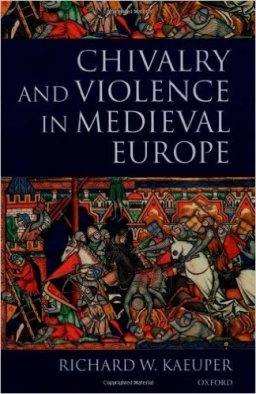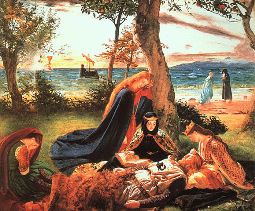Chivalry: Might is Right… Not Quite What You Think

I love writing knights because they had such a unapologetically simple way of looking at the world (first blog entry in this series here).
The knightly world view was internally consistent, but must have been infuriating to anybody with a logical turn of mind. In Swords Versus Tanks, I had fun imagining just such a conversation:
Ranulph swept his arm around the cell to indicate the corpses. “God has just shown you His will.”
“Knights!” The red-haired girl gestured at the carnage. “You think that was a trial by combat.” Her eyes narrowed. “You wear a somewhat soiled arming jacket, so it was defeat in battle which brought you to this dungeon. Was that also God’s will, Sir Ranulph?”
“I suppose that God wanted me here to save you,” said Ranulph, with a vague, familiar, feeling that he was going to regret arguing with her.
In fact — if Kaeuper’s Chivalry and Violence is to be believed — real knights tended to take things further with an utterly glorious piece of reasoning:
Knight: “God granted me victory, therefore I am more pious than the dead guy.”
Priest: “But you still need to do penance!”
Knight: “Penance, Sir Priest? Pah! Wearing armor in the field is mortification enough.”
Partly this was lazy thinking at work.
Sometimes, especially reading early(er) Medieval texts it feels like the transcript from a very very “lite” roleplaying game where one stat applies across the board.
For example, William the Marshal was “courtly”, not just because he was polite and charming, but also because he was able to devise cunning stratagems such as: dispersing the English army with orders to rally, thus tricking the French into demobilising and thus rendering themselves defenseless. “I love the smell of burning hovels in the morning…”

However, this line of thinking was also pushback against the Church, almost a way of closing down annoying conversations. Knights were religious, but at the same time had a tradition of anticlericalism, probably because the Church was always trying to define knighthood to serve its own ends — a bit like well meaning adults telling teenagers “It’s cool to do your chores and respect your elders…”
Some of these ends were entirely reasonable, for example not destroying farm implements, and not fighting your neighbours on a Friday.
Some were arguably for the greater good, such as rules about who can pursue a Just War, which pretty much came to outlaw private war.
However, there was also a measure of tribal self interest with injunctions for knights to protect priests and serve the church, and of course to do penance, make pious donations, especially land… the Church liked land.
I imagine it as similar to working in one of those places where the IT support department is has too much influence. People need their PCs and network access, but don’t like being snarked at and patronised. They especially don’t like it when IT support gets to set the firewall policies, or worse, when it starts swallowing up budget on vague infrastructure projects with mainly theoretical benefit.
So, when you look at the evidence for how actual knights saw chivalry, you get something a bit different from what’s in the writings of churchmen. In Le Morte De Arthur, Sir Thomas Malory makes the first bishop the son of the first knight! He also portrays the ideal knightly life cycle as:
Squire > Knight Errant > Lord > Hermit…
Yes, knights don’t retire to monasteries. Instead they preserve their individualism by going off solo to battle for their souls in the wastelands.
Needless to say, Malory’s take on the Grail Quest also differs from his religious sources. The Grail (which I still think is not a force for good) decimates Arthur’s court, but though a handful of pious do-gooders do achieve it, Sir Lancelot is pretty much the star of the show, dealing with the knotty moral questions about violence that most knights avoided (interesting paper here).
Perhaps Malory, who was reputedly languishing in prison at the time, was getting flashbacks to some of the unedifying events in the closing stages of the Hundred Years War — after all, the English had been defeated so God must have been angry with them for some reason…
Finally, lazy thinking and pushback aside, the knightly spiritual way of framing “kill or be killed” is not quite “might is right”. Rather it is, “God decides victory.”
If you remove God from equation and then unpack it, you end up with something more modern sounding:
Don’t fret about your own survival, if there’s a bullet with your number on it there’s nothing you can do. If you win, don’t get cocky (kid), it could be you next time. For the same reason, don’t feel bad, either.
Really, just a healthy fatalism; a mature acceptance that #### happens. Though occasionally they did crazy stuff — we’ll come to that in another blog entry — in a lot of their attitudes, Medieval knights were not so different from modern professional soldiers.
M Harold Page (www.mharoldpage.com) a life-long student of all things knightly, is poised to launch is old-school Heroic Fantasy trilogy, Swords Versus Tanks. While you’re waiting for that, you can buy his action-packed Dark Age adventure, Shieldwall: Barbarians! (UK, Epub) and also learn how to plan and write your novels using Storyteller Tools (UK, Epub).
Would you also see a similarity in the attitudes of Roman soldiers and centurions? A strong sense of companionship, innate sense of superiority, touch of fatalism? Does the profession of arms tend to produce this same mindset, regardless of era? I wonder.
Barbara Tuchman’s “A Distant Mirror” is currently providing me a distinctive view on chivalry, the good, the bad, and the ugly. Mostly the latter two.
Eugene R.
I get the feeling it’s more the opposite in people with that mind set might be inclined to a profession of arms. And even if they don’t fully think that way in the beginning, the seed of it is certainly there.
With the Roman soldiery (at least after the rise of the professional army) the situation is complicated by the fact that they lived apart from the rest of society. It really became a separate culture, which is why the Roman army becomes so dangerous to the civil government. Knights (at whatever point in their life cycle) had to live in their society in a way that Roman soldiers didn’t.
Great piece–I like the comparison of the Church’s status to the IT Dept., especially.
Thought knights were mostly born into their class, and knighthood was a marker for class, there was this concept of the Active Knight, i.e. one who pursued the profession of arms.
I think there are only so many ways of coping with a vocation involving kill or be killed. Knightly quasi-fatalism is interesting, not because it was unique, but because it was systematised.
Did any other martial culture have a similarly articulated coping system?
Would you hazard a comparison of European knights and Japanese samurai? I think that the latter seem even more integrated into their society as the expectations existed for them to contribute on various fronts (social, aesthetic, spiritual) to a more significant degree than their European counterparts, where being a dedicated warrior was a more acceptable lifestyle.
@Eugene R.
I don’t pretend expertise in Samurai. However I have noted that the Book of Five Rings and the European equivalent (“Dobringer” 1389) have very different approaches to dealing with multiple opponents.
Five Rings talks about out maneuvering the enemy and how to cut them. Dobringer calls anybody who takes on multiple opponents stupid, then recommends running away, letting your enemy get strung out, then taking them out in detail.
So you could argue that knights were slightly more “victory orientated” than samurai.
Also, the 47 Ronin would make no sense in a European context; knights would have avenged their lord then either kicked off a civil war or gone into exile – not an option quite so open to Japanese warriors! Geography at work I think.
Having said all that, in the 11th-12th century professional active knights seem to have been largely landless, or else so impoverished as to largely subsist off a military profession, so there is a lot of resonance there. It’s only later that knighthood become an important social status, and in fact from the 14th century onward, people started avoiding knighthood because of the expense of maintaining a knightly station and the demands of local bureaucracy.
The Bushido of the Samurai is as close to reality as the Chivalry of the Knights. During their time it was an ideal, but very often more a theoretical one than an actual way of life and conduct.
The Bushido as known today was invented in the 19th century by a reactionary writer who pretty much created his own fantasy version of the good old days. I think a development that mirrors quite closely the gross rewriting of medieval history by the upper class of Victorian England. Like European knights, the Samurai rose out of bands of mercenaries who somewhat unexpectedly found themselves in a position where they could actually run the country themselves under the rule of their superior officers.
@Martin K
That doesn’t surprise me. The 19th century was a great time for invented national traditions.